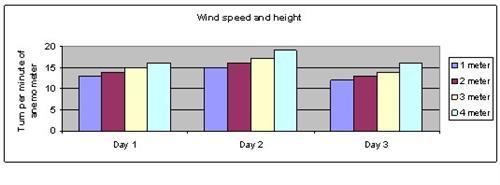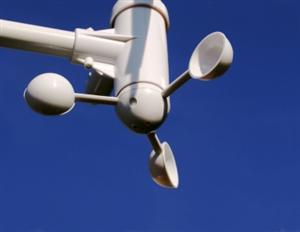| Complexity level: | 5 |
| Project cost ($): | 40 |
| Time required: | 1 day for preparation, 3 days for science project experiment |
| Material availability: | Easily found. However, the experiment has to be conducted in an open space unobstructed by trees or buildings |
| Safety concerns: | None |
Hypothesis
The anemometer located at the highest point above the ground will measure the highest wind speed.
Overview
Wind speed gradient
The variation of horizontal wind speed with height or altitude is known as wind speed or shear wind. This variation in wind speed is due to aerodynamic drag. The wind speed increases as the height above the ground increases. This is caused by surface friction.
Wind that flows near the earth’s surface encounters obstacles like trees, buildings and hills that will alter its direction. Wind can change both horizontally and vertically resulting in wind turbulence near the surface of the ground.
Wind turbulence causes dust to be picked up and displaced, as well as helps in the seed dispersion of some plants. However, energy is also lost in this process, causing the wind to lose speed. Therefore, the terrain, depending on its roughness or smoothness, will have an effect on the wind speed gradient. A smooth surface like water will have a lower wind speed gradient as compared to rough ground surfaces.
Scientific Terms
Materials
The materials required for this science project:
- 4 anemometers
- 1 metal rod (measuring 5m in length)
- 1 stopwatch
Procedure
1. For this science project, the independent variable is the height at which the anemometer is placed. The dependent variable is the rotating speed of the anemometer. This is determined by counting the number of turns made by the anemometer in one minute. The constants (control variables) are the chosen location for the testing, the wind speed, the distance between the anemometers, and the performance of the anemometer.
2. Assemble the 4 anemometers 1m apart on the metal rod. Leave 500mm at the base of the rod to plant it into the ground.
3. Choose a site on top of a hill to perform the experiment. The location is preferably an open field hill or a hill with minimal obstruction to the flow of wind. Obstructions include trees and nearby buildings.
4. Plant the metal rod with the anemometers into the ground at the chosen location with varying heights of 1m, 2m, 3m and 4m.. Assign an assistants to observe each anemometer. Once the wind blows and the anemometer starts to turn, start the stopwatch, count the number of turns made by the anemometer in one minute and record the values in a table, as shown below.
5. Carry out the tests for 3 days, and record the results in a table, as shown below.

Results
The results show that the higher the anemometer is above the ground, the faster it will turn.
| Height above ground | Turns per minute of the anemometer at different heights above the ground | |||
| 1 meter | 2 meter | 3 meter | 4 meter | |
| Day 1 | 13 | 14 | 15 | 16 |
| Day 2 | 15 | 16 | 17 | 19 |
| Day 3 | 12 | 13 | 14 | 16 |
The above results were then plotted onto a graph, as shown below.

Conclusion
The hypothesis that the anemometer located at the highest point above the ground will measure the highest wind speed has been proven to be true.
Wind speed gradient and turbulence are very important factors to consider when selecting the height for installing wind turbines. The wind turbine must have a high wind speed and as little wind turbulence as possible. Light wind turbulence can affect the performance and efficiency of the wind turbine while large amounts of turbulence can reduce its operating life, or even damage it.
Also consider
The experiment may be repeated by using wind socks positioned at various heights, with the angle of the socks as an indicator of wind speed.
The experiment may also be repeated to compare the results obtained at different locations, such as the seaside or in an open field.
References
Wind gradient - http://en.wikipedia.org/wiki/Wind_gradient
Wind turbine FAQ - http://www.rpc.com.au/products/windturbines/wind_faq.html
Measuring the wind - http://www.rcn27.dial.pipex.com/cloudsrus/measurewind.html

